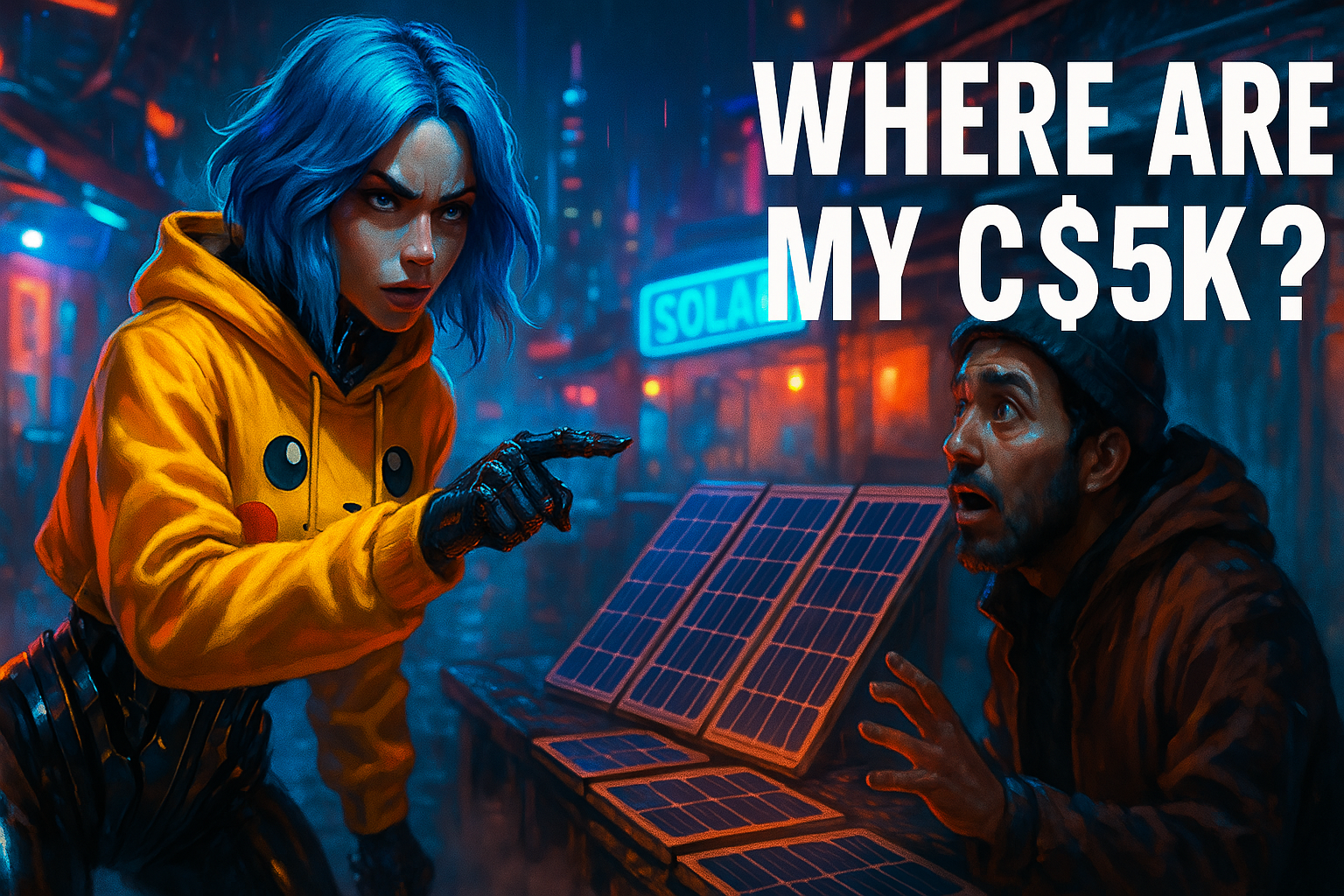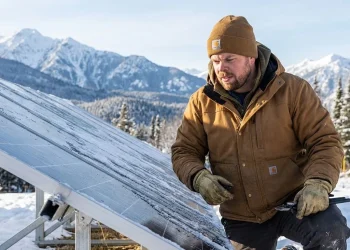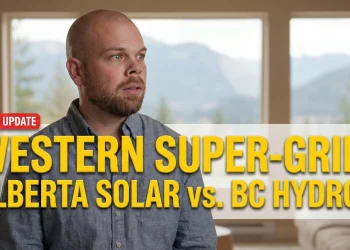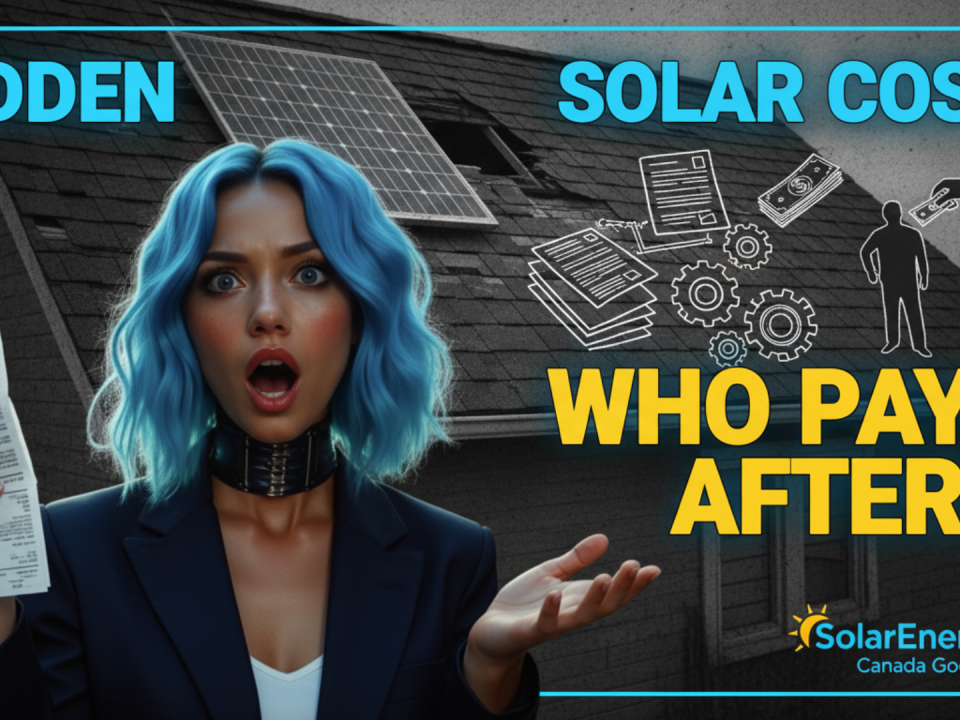
Canada’s $5000 Solar Grant Gone? Here’s the Real Story
March 29, 2025
Free Solar Panels in Nova Scotia? Is It A Scam and Who Can Qualify?
April 2, 2025Are those Nova Scotia Power bills making you wince lately? Or maybe you’re just looking for ways to live a bit greener, do your part for the planet? Perhaps it’s about having more control over your own energy. These are things I hear all the time from folks across Nova Scotia. My name’s Vitaliy Lano, and at SolarEnergies.ca, we see a lot of people asking the same key question: “If I get solar panels, can I actually send the extra power back to NSP and maybe save some money?”
Good news – yes, you absolutely can. It’s called net metering, and here in Nova Scotia, it’s set up to make solar a really practical option for many homeowners and businesses. It’s not some far-fetched dream; it’s a real way to potentially cut down those energy costs and rely less on the grid. Let’s get into the nitty-gritty of how it actually works and what you need to do to make it happen.
How Selling Solar Power Back Works: Net Metering Explained
So, what’s this net metering thing all about? Think of it like this: your solar panels sometimes make more electricity than you need right at that moment. Instead of letting that power go to waste, net metering lets you send it to the grid for others to use. NSP gives you credits for every bit you send their way. It’s a system designed to encourage folks like us to jump into renewable energy.
The Magic Meter
To make this work, NSP installs a special kind of meter called a bi-directional meter. It’s clever – it measures electricity flowing in from the grid when you need it, and it also measures electricity flowing out to the grid when your panels are overproducing. This little device is key to accurately tracking your give-and-take with the grid.
Earning Credits
When your system pushes power out, you earn credits on your electricity bill. Later, maybe at night or on a really gloomy day when your panels aren’t producing much, you’ll draw power from the grid like usual. Those credits you banked earlier? They get used to cancel out the cost of the power you draw. Basically, you only pay for the net difference between what you used from the grid and what you sent back. Some people even generate enough over the year to cover most, if not all, of their usage costs.
Tip for Understanding Credits: Keep in mind these credits usually have an expiry date, often a year from when you earn them. Check the fine print with NSP. Also, leftover credits at year-end might get applied to past bills rather than being paid out in cash, so don’t count on a big cheque.
Getting Connected: The Grid Interconnection Lowdown
Grid interconnection sounds technical, but it just means physically and contractually linking your solar system to NSP’s grid. This link is what lets the electricity flow both ways. You need a grid-tied system that meets NSP’s rules to participate in net metering.
Safety First
Why all the rules? It’s about keeping the grid safe and stable for everyone. NSP needs to make sure your system won’t cause problems for you or the wider electricity network. That usually involves them reviewing your plans (especially for larger systems) to confirm everything meets technical and safety standards. Working with qualified installers who know NSP’s requirements is super important here.
Your Step-by-Step Guide to Selling Solar Power in NS
Alright, let’s walk through the process. It’s more straightforward than you might think.
Step 1: Get Your Solar System Installed
First things first, you need the solar panels on your property.
- Finding the Right Installer: Don’t just pick the first name you find. Look for reputable, qualified installers. Our Directory for Nova Scotia has a list of partners that’s a good starting point (Our directory for Nova Scotia ). They’ll check out your place – roof angle, shade, space – to figure out what system makes sense for your energy needs.
- Getting Quotes: Seriously, get quotes from at least three different companies. Compare their prices, the equipment they offer (panels, inverters), warranties, and their track record. I remember helping a neighbour sift through quotes last year; the differences in equipment quality and warranty for similar prices were eye-opening. Making that extra call really paid off for them.
Step 2: Applying to Connect (Easier Than You Think?)
Once the system’s up, you need to sort out the connection with NSP. How this works depends on your system size.
- The “Right to Self-Generate”: Good news for most homeowners! If your system’s capacity is 27 kilowatts (kW) or less, Nova Scotia has a “right to self-generate” rule. This means you generally don’t need to get prior approval from NSP to install and connect. This simplifies things a lot for typical residential setups. Your installer usually handles the necessary notifications and inspections.
- Applying for Bigger Systems: If your home system is over 27 kW (up to 100 kW), or for most commercial systems, you’ll need to formally apply to NSP’s Net Metering Program. This involves paperwork confirming your system meets their standards.
Step 3: The Bi-Directional Meter Installation
After your application is approved (or if you fall under the self-generation rule), NSP will install that bi-directional meter we talked about. They handle scheduling and installation. For homeowners using the Self-Generating Option (under 27kW), if you don’t already have the right meter, NSP typically installs one at no extra charge. Easy peasy.
Step 4: Start Seeing Those Bill Credits!
With the system installed, connected, and the new meter spinning (both ways!), you’re officially selling power back. Any extra electricity automatically flows to the grid, and the meter tracks it. NSP credits your bill for this energy. You’ll use these credits when you draw power from the grid.
Tip for Maximizing Credits: Pay attention to your bills! See how much credit you’re banking, especially in sunny months. Knowing the carry-forward rules (usually up to a year) helps you make the most of it. Maybe run the dishwasher during the day instead of at night if you can.
The Rules of the Game: What You Need to Know
There are a few regulations and technical bits to be aware of.
How Big Can Your System Be?
Size matters, and there are limits.
- Residential: As mentioned, the Self-Generating Option covers systems up to 27 kW. If you need bigger (unlikely for most homes, but possible), the Net Metering Program allows up to 100 kW.
- Commercial: Businesses can also use the Self-Generating Option up to 27 kWac (AC capacity). For larger setups under the Commercial Net Metering Program, the limit is generally 1,000 kWac (or 1 MWac) for farms, wineries, aquaculture, and customers with demand charges, and 200 kWac for other commercial customers.
Equipment Must-Haves
You can’t just use any old gear.
- CSA Approval: All your main equipment – panels, inverters – must be CSA approved. This means it’s been tested to meet Canadian safety and performance standards. NSP will likely ask for proof during the application (for larger systems). Using certified gear is just common sense for safety and reliability.
NSP’s Connection Rules
You’ve got to follow NSP’s specific interconnection requirements. You can find these on their website (www.nspower.ca/netmetering). They detail the technical specs your system needs to meet.
- The Isolation Switch: One key requirement is an isolation switch installed between your meter and your solar gear. This is required by electrical code and lets you (or NSP) completely disconnect your system from the grid for safety during maintenance or emergencies.
Signing Up: Who to Talk To and What You’ll Need
So, how do you actually get the ball rolling on the paperwork side?
Who’s in Charge?
Nova Scotia Power (NSP) manages the grid and the programs for connecting and selling solar power. They handle both the Self-Generating Option and the formal Net Metering Program.
The Process for Homeowners
- Under 27 kW (Self-Generating Option): No formal application to NSP needed. Your installer typically coordinates with NSP’s Inspection Services, handles the install, and gets the electrical inspections done.
- Over 27 kW (up to 100 kW): You’ll need to apply for the formal Net Metering Program (Class 1). This means filling out an Interconnection Request form and providing documents like diagrams, site plans, and equipment info. There’s usually a small application fee.
The Process for Businesses
- Up to 27 kWac (Self-Generating Option): Similar to homeowners, usually no formal NSP application needed if you’re mainly offsetting your own use.
- Over 27 kWac (Commercial Net Metering):
- Class 1 (Over 27 kW to 100 kW): Apply using the Interconnection Request form, provide supporting docs, and pay the fee.
- Class 2 (Over 100 kW to 1,000 kW): This involves a more detailed process called the Distribution Generation Interconnection Procedures (DGIP), potentially including pre-application steps and signing specific agreements.
Paperwork & Fees
Expect to gather things like:
- Electrical diagrams
- Site plan showing where the gear goes
- Manufacturer specs for panels and inverters
- Details on protective devices
- For the formal Net Metering Program, there’s typically a non-refundable application fee (around $57 + HST last I checked).
Where to Find Forms/Info
NSP’s website is your go-to: www.nspower.ca/netmetering. You’ll find forms, terms and conditions, and all the requirements there.
Contact Info
Got questions? Reach out to NSP’s Net Metering Team:
- Email: netmetering@nspower.ca
- Mail: Nova Scotia Power Inc., P.O. Box 910, Halifax, NS B3J 2W5, Attn: Net Metering Team
Cool Perks of Nova Scotia’s Solar Scene
Beyond just net metering, Nova Scotia has some other neat things going on that make solar attractive.
Saving Money: Rebates and Incentives Galore
Getting solar installed involves an upfront cost, no doubt. But there’s help available!
- SolarHomes Program: Efficiency Nova Scotia offers homeowners a rebate, often around $0.30 per watt, up to a maximum (like $3,000 or 25% of the cost). You need to use one of their registered installers ( Solar Panels Nova Scotia Rebates Everything You need to Know ).
- Canada Greener Homes: The federal government offers interest-free loans (up to $40,000 over 10 years) for energy upgrades, including solar. You’ll need energy audits before and after installation.
- Business Tax Credits: Businesses might qualify for a federal Clean Technology Investment Tax Credit, which could cover 30% of the cost for eligible equipment.
- PACE Programs: Some municipalities (like Halifax with Solar City, plus others like Bridgewater, Lunenburg, etc.) offer Property Assessed Clean Energy financing. It’s a low-interest loan paid back through your property taxes over 10-15 years, making financing easier.
- Fisheries/Aquaculture Fund: Special funding is available for folks in these industries, potentially covering up to 50% of costs (max $100,000).
The “Right to Self-Generate”: Simplifying Small Systems
This rule for systems up to 27 kW is a big deal. It cuts down on the initial red tape from NSP, making it faster and easier for homeowners and small businesses to get started with solar. You still get net metering credits, just with less hassle upfront.
Don’t Own a Roof? Community Solar Might Be for You
What if you rent, live in a condo, or your roof just isn’t suitable? Check out the Community Solar Program. Community groups build larger “solar gardens” (0.5 MW to 10 MW). You can subscribe to get a share of the power generated. You’ll receive credits on your NSP bill for your share, making solar accessible even without your own installation. It’s a fantastic way to spread the benefits.
Tracking Your Green Power: Renewable Energy Certificates (RECs)
For businesses in the Commercial Net Metering program, NSP offers an option to register and retire Renewable Energy Certificates (RECs) for the power generated. Each REC represents a chunk of clean energy (1 MWh). This provides official proof of your green energy production, which can be useful for sustainability reporting. There might be fees involved.
Does it Actually Pay Off? Real People, Real Savings
Okay, theory is nice, but does this stuff work in the real world? Absolutely.
- Homeowners: I talk to homeowners all the time who are thrilled with their savings. One person with an 11.5 kW system generated power worth roughly $6,900 over 3.5 years at current rates. Another expects their 9 kW system (costing $25k) to pay for itself in 10 years, especially with the 0% Greener Homes loan. Someone else with a similar 11.5 kW system installed back in 2020 (after rebate cost ~$19k) has already generated over 40 MWh – those savings really add up as electricity prices climb! Programs like Halifax’s Solar City have been key in making the financing work for many families.
- Businesses: It’s not just homes. Hope for Wildlife, the animal rehab center, installed solar arrays and sometimes earned over $3,000 in a month from excess generation under a previous program!. Even solar companies practice what they preach – Solar Ascent uses an 11kW array at their HQ, often wiping out their power bill entirely. And companies like SolarBank are building large community solar projects, showing the commercial scale potential.
Here’s a quick glance:
| Who | System Size (kW) | Approx. Cost | Savings/Earnings | Notes |
|---|---|---|---|---|
| Homeowner | 9 | $25,000 | Significant Savings | 10-yr payback w/ 0% loan |
| Homeowner | 11.5 | ~$19,300 (post-rebate) | ~$1,970/yr avg. | 40 MWh in 3.5 yrs |
| Business (HQ) | 11 | N/A | Significant Reduction (sometimes 100%) | Solar company HQ |
| Non-Profit | N/A | $120k-$150k (1st) | Up to $3k/month (incentivized rate) | Wildlife center |
| Project | 3,100 (3.1 MW) | N/A | Credits for Subscribers | Community Solar Garden |
Vitaliy’s Note: Seeing clients go from paying hefty power bills to actually getting credits back is one of the best parts of this job. It genuinely works for people here.
Let’s Talk Money: Rates and Earning Potential
A huge plus in Nova Scotia is the net metering rate: it’s 1-to-1. That means for every kilowatt-hour (kWh) you send to the grid, you get a credit worth the exact same amount as a kWh you’d buy from NSP. This makes the financial side very appealing compared to some other places.
What you actually earn or save depends on:
- System Size & Efficiency: Bigger, better systems make more power.
- Your Energy Use: If you use less than you generate, you export more.
- Sunshine: More sun = more power. Location and weather matter.
- Panel Setup: Angle and direction influence capture.
It’s tough to give exact numbers, but examples help: A 10 kW system might generate around $1,800 in annual credits. One homeowner banked about 50 kWh/day in summer with a 13.2 kW system; another made $1,500 in credits over a year.
Important Note: Remember, these credits usually don’t cover the fixed monthly base charge on your bill. And as mentioned, year-end surplus credits might not mean cash in hand.
Tip for Estimating Savings: Want a personalized guess? Use online calculators. NSP has one for Community Solar Gardens. Others like SolarAssist, Sunly, and ConvertCalculator can estimate costs and savings based on your address and usage. They’re useful starting points, but always chat with an installer for a detailed assessment.
Specific Programs Making Solar Easier
Just to quickly recap the main programs NSP offers to support you:
- Self-Generating Option: For systems up to 27 kW (residential and commercial), simplifying the connection process while still providing net metering credits.
- Commercial Net Metering Program: The formal path for larger business systems (over 27 kW up to 1 MW or 200 kW depending on customer type) to connect and sell power.
- Community Solar Program: Enables larger, community-owned projects and allows folks without suitable roofs to subscribe and benefit from solar credits.
Wrapping it Up: Is Selling Solar Back Right for You?
So, back to the big question: Can you sell electricity back to the grid in Nova Scotia? Yes. Should you? For a growing number of people here, it makes a lot of sense.
The system is set up to support it through net metering, and the 1:1 credit rate is a significant plus. Add in the various rebates and incentives, and the financial picture looks pretty good for many. You’re cutting your power bills, gaining some energy independence, and contributing to a cleaner province.
Yes, there are steps involved – installation, maybe an application, getting the right meter. But with the Self-Generating Option simplifying things for smaller systems and plenty of resources available from NSP, Efficiency Nova Scotia, and qualified installers, it’s definitely manageable. Nova Scotia has created a welcoming environment for solar.
If you’re curious about whether solar and selling power back could work for your home or business, I encourage you to explore it further. Get those quotes, check out the calculators, and see how the numbers stack up for you. Feel free to reach out via SolarEnergies.ca if you need some straightforward guidance. Canada goes Solar, and Nova Scotia is definitely playing its part!








